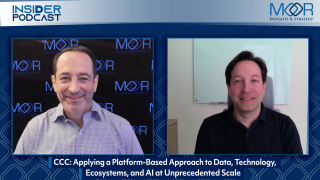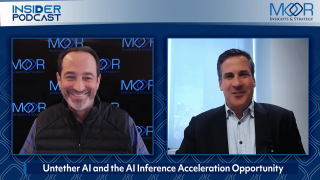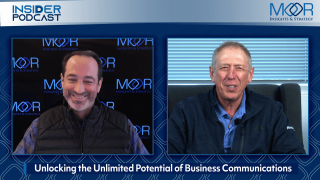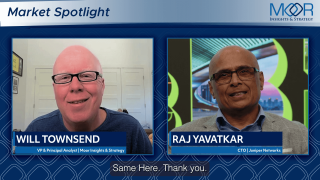On this episode of the Moor Insights & Strategy Insider Podcast, host Patrick Moorhead is joined by Venkat Kodavati, Senior VP & GM, Wireless Products, and Vikram Gupta, Chief Product Officer and Senior VP & GM, IoT Processors, at Synaptics.
The Intelligent IoT, with its combination of AI-infused sensing, processing, and connectivity, is changing industries, from the smart home and security to mobile devices, automotive, the enterprise, and industrial automation. With the change comes an opportunity for innovation, such as the appropriate application AI at the Edge, where designers must strike the right balance of functionality, power consumption, performance, cost, time to market, privacy, and ease of use to ensure an exceptional user experience.
During their conversation, Patrick, Venkat, and Vikram discuss the opportunities, challenges, and suitable architectural approaches to accelerate next-generation Intelligent IoT devices.
This is a conversation you don’t want to miss!
You can watch the full episode here:
Or listen to the episode here:
TRANSCRIPT:
Patrick Moorhead: Hi, this is Pat Moorhead with Moor Insights and Strategy. We are here for another Moor Insights and Strategy Insider podcast, and we are here talking about IoT with executives from Synaptics. Welcome to the show, gentlemen.
Venkat Kodavati: Thank you.
Vikram Gupta: Great to be here.
Venkat Kodavati: Great to be here, Pat.
Vikram Gupta: Thanks, Pat.
Patrick Moorhead: Yeah. Hey, I know we have the titles underneath your faces here in the video, but can you talk to us about what you do for Synaptics? Vikram, we can start with you.
Vikram Gupta: Sure. I’m Vikram. I am the GM of the embedded and edge processing division here at Synaptics. The products that we offer here from this division are SOCs that actually go into a variety of products such as setup box, OTT platforms, wiped phones, audio headsets, and also the broader IOT market. I also double as the Chief Product Officer here at Synaptics. I’ve been in the industry for about 30 years across microprocesses, connectivity, and the IOT. That’s about it from my side.
Patrick Moorhead: Excellent. Venkat, how about yourself?
Venkat Kodavati: Hi, I’m Venkat Kodavati. I’m the CPGM of the Wireless Products division at Synaptics. At my division, we take care of all the wireless products that Synaptics actually brings to the market, namely wifi, Bluetooth, ZigBee, GPS, you name it all, basically everything under wireless is part of my organization. I’ve been in the wireless industry for the last 25 years, most of my time I spent at Broadcom and then I moved to Synaptics recently three years ago.
Patrick Moorhead: Excellent. I’m so happy to hear that we’re talking about AI. As an industry analyst, we love pandemonium and opportunity because that makes industry analysts really, really busy and I think I’ve spent the last 90% of my time in the last 90 days just talking about AI, AI on the edge and all the way to the data center, and IaaS, PaaS and SaaS services that go along with this, so I’m really looking forward to this. I’m just guessing, Vikram, it’s kind of a joke here, that this conversation might involve AI, but can you tell us what you mean by intelligent IOT? A lot of companies throw around the IOT word, and typically their definition is based on the space that they’re in, the problems they’re solving. But Vikram, what is the intelligent IOT?
Vikram Gupta: Yeah, sure, Pat. I think before we talk about the intelligent edge, we should first talk about what the IOT is. I mean, I think we all know that the IOT is something that’s taking a lot of root in a number of industries given the whole trend around digitalization. If I think about IOT products, I really think about a processor, a sensor, and some type of connection that basically takes the sense data that is processed and sends it back to the cloud, does something meaningful with it, and then gets it back to the device to then turn it into an outcome. I think we all can agree there’s a lot of utility for IOT devices. What makes these devices even more useful is if they can be discerning in a contextual sense.
Vikram Gupta: Given the improvement in processing power and the advancement in algorithms and so on, what people are trying to do more of, which I’m totally behind, is actually take all of this and put it into these IOT devices so that there is more outcomes that actually favor the applications that these products are used in. There’s more privacy of the data, and it also actually results in a better power consumption profile for a lot of these devices, which as you know, energy’s a big deal these days. The intelligent edge is therefore going to be a meaningful advancement of the IOT the way I see it and actually result in a lot better outcomes for the industry as a whole.
Patrick Moorhead: Yeah, I mean history’s on your side. I mean, if I look back 30, 40 years, the edge is where processing happens to take place over time, closer to where the data is created. We went from mainframes to mini computers, mini computers to client server, client server to phone to server, and then the far edge server with the intelligent IOT. I think history is with you on this 100%. I’ll ask you a follow-up. What are some of the key applications? Where are you seeing the heat and light with the intelligent IOT kind of workloads?
Vikram Gupta: I think you could break it down into a couple of different categories. In general, wherever there’s a sensory aspect to the IOT device, which around audio and let’s say vision, there can be actually an evolution of basically the application use case from an AI perspective that actually gives a better user result. What we are doing is we are looking at this in two ways. One is how can we provide an outcome to the end user through these products that we offer by actually doing certain things such as object identification or people identification and so on. There are certain things that we can do that will actually give a better user experience at the end of the day in these products.
Vikram Gupta: There’s also another category of applications that we are doing which are sort of under the hood. If you can think about, let’s say a video processor that’s actually taking images and upscaling it, you can actually have AI models that are custom-built from a hardware point of view that actually take low resolution images and upscale them through AI techniques to actually give you a better user experience. I call this out differently because when you look at a video image, you’re expecting it to be in good resolution. AI is sort of inherently making a product better under the hood, and that’s absolutely a class of applications that we are interested in servicing from a Synaptics perspective. Both a user-focused thing such as cameras and so on or in video setup box platforms, these are some of the examples that we actually can offer AI in the vision category.
Vikram Gupta: Audio, we can come across number of different examples as well, such as echo cancellation, also listening for anomalies and so on through sensing audio. In the industrial settings, these are things that we are actually looking at to further AI into a variety of different applications. Just some examples from our side.
Patrick Moorhead: I think those are great examples, and whether it’s anomaly detection, human presence detection, face detection and people counting in retail, industrial automation like you talked about listening to sound and doing predictive maintenance on those algorithms. It is interesting how five years ago coming up with these were difficult, but I think through the hard work of companies like yours, your customers, and your customer’s customers, these are becoming more normalized. All this seems very straightforward, Vikram. Venkat, I have questions for you too, don’t go away.
Venkat Kodavati: No worries.
Patrick Moorhead: But, why aren’t we here yet? What are some of the challenges that we’re seeing with the intelligent IOT? It’s like, “Hey, we have standards now.” Remember five years ago we were talking about the lack of standards? Then, we’ve seem to have focused in on a few. But what’s holding up the growth right now or what are some of the challenges that you’re seeing with your customers?
Vikram Gupta: I think we’re sort of in the early stages of this wave of intelligent devices and I think one of the things that we notice with our customer base is that I think a lot of them are interested in adopting AI into the mix, but they’re not exactly sure how. There is a opportunity for companies like ours to actually provide the right kind of solutions to the customer base as a prepackaged sort of offering and then work with them in a meaningful fashion to actually enhance the value of their end products. In a sense, we are trying to make the customer journey from an AI adoption point of view much more easier for our customer base. There’s a lot of ground that needs to be covered in this area, and we are investing a lot in terms of making algorithms better and we have plans to actually offer full stack AI solutions so that customers just come to us with their data sets and then we are able to help them generate the right kind of models and ultimately implement them on our devices.
Vikram Gupta: There are a number of things that we are looking to actually really make AI, across all these different applications, solve meaningful problems, a lot of ground to be covered.
Patrick Moorhead: Yeah, and by the way, I joke that I had a real job for over 20 years before I started my analyst firm, but you’re essentially taking what used to be in the industry, I would call it bag of parts, which says, “Okay, hey, here’s a chip, maybe I’ll give you some software to run with that, half-baked drivers to go in here, and maybe I’ll help show you how you would actually put that into a product,” but you’re in this evolve state, HDKs, SDKs. But I really like what you said about actually helping them with the models, that’s kind of next level, and I think at least what I think is unique. I like that because it means your customers have to do less, right?
Vikram Gupta: That’s correct.
Patrick Moorhead: And time to market should be improved.
Vikram Gupta: Exactly.
Patrick Moorhead: Because you’re also doing this across a wide variety of devices and use cases, so I really do like that.
Patrick Moorhead: Venkat, man, I’m going to ask you all the questions now for the next 27 minutes. Just kidding.
Venkat Kodavati: No worries.
Patrick Moorhead: Vikram talked about the opportunity, and I think we are in the mutual agreement club about the importance of intelligent IOT at the edge. We understand from a Synaptics point of view what’s that defined. We talked about some use cases and some of the impediments to get there. What specifically are you doing… I mean we talked a little bit about these models, but what are you doing with your customers to address the challenges that Vikram talked about?
Venkat Kodavati: Yeah, we provide connectivity as part of our IOT solutions. As Vikram was talking about, making it intelligent AI enabled systems, connectivity is the pretty integral part of this whole solution because consumers come to expect a solid, always on connection to the internet. They may want privacy and want to have anonymity, but at the same time they want to get the outcomes communicated to them. For example, you take a security camera, you don’t want the video to be actually uploaded to cloud, but you do want to know if somebody showed up at your door as an alert for example. These ones, people want to run it on batteries for a long time, so the low powered-ness is the key in the IOT. That’s where we actually excel quite a bit. We make all of our connectivity solutions, ultra-low power.
Venkat Kodavati: One of the biggest things people come to expect is that it’s a robust connection, especially the solution providers don’t want to field any customer calls on a connectivity issue. Again, that’s one of our strong points is that our performance is the best in this IOT field and our interoperability is… No one else can match. Those are the things that we bring to the table to make this overall intelligent IOT solution a very pleasant experience for the user. The other thing that we do is that because we have both the processing, as Vikram was talking about, and the connectivity as part of Synaptics portfolio, we integrate them before even we roll it out to the customers so that it becomes much more easy to roll it out to the end customer, so that the lift from the solution providers is minimal because we’ve ironed out all the issues beforehand and provide a solid solution at the end. That’s how I view connectivity kind of play a role into this whole thing.
Patrick Moorhead: The combination of edge AI processing, very low wireless connectivity and the power that goes into the overall solution there, it is amazing. Even five years ago we were looking at battery life for some of these intelligent IOT endpoints in terms of days and weeks and now we’re looking at them in terms of months and years.
Venkat Kodavati: Yes, exactly.
Patrick Moorhead: It’s just really a testament to the great work that Synaptics and others have done to make this happen. It was funny, I was early in the intelligent IOT, at least for my house, and there’s definitely a line of the old stuff and the new stuff. I’m finding myself, and you probably need more end customers like me, I’m replacing a lot of those first generation devices that I bought five years ago. If nothing else, I don’t have to charge them up every week or month or the red light goes on and I get the notification I have to come in and it just goes out, my camera just goes out. This is great stuff. Now, from a customer point of view, you hit on a couple of things, but can you reiterate for the audience, what is the benefit to your customers of the combination of the two, maybe related to cost, time to market, things like complexity? Can you talk a little bit about that?
Venkat Kodavati: Sure, yeah, I think you touched on all the points there, Pat. I think the combination of having in-house processing and connectivity makes the overall solution lower cost and easy to adopt. At the same time, we can actually combine some of the features from both solutions. For example, you take wireless sensing, wifi is everywhere and you can actually use the signals to process and find out if somebody’s in the room or if actually they have actually fallen down. There’s many things that you can extract from the signature of the wireless signals. That we can actually do quite well because we are on the same solution, we can exchange a lot more information between our devices, and that way we can arrive at intelligent outcomes. That is not possible if you try to actually put together two off-the-shelf components. Whereas because we are integrating it internally, we work with other teams to identify the signals that we need to make it much more low power and a much more faster response so that the overall solution actually works like a charm.
Patrick Moorhead: No, I think that’s great. Sometimes we throw around this shorter time to market thing like it’s nothing. I’ve run product management, product marketing groups before and it can mean a difference between hitting the cycle and not hitting the cycle, the consumer cycle.
Venkat Kodavati: Yeah, that’s quite important.
Patrick Moorhead: Consumer IOT is the second half of the year, if you miss second half you might as well just pack it up and go home, and the ability to maybe squeeze a cool feature in there, “Hey, I can shorten this cycle here, but it gives me maybe a little bit more resources also that I can put on the differentiators.” That’s what I like too, which is not all smart thermostat companies need to be experts in certain layouts or the interconnectedness between the edge AI processing and the wireless connectivity. But no, this is great. I’m going to ask just one more question. Hang in there with us to each of you, and I’m going to start with Vikram. We talked about where we are today, how you’re servicing your customers. I’m curious, what can you share about what you’re looking at in the future? I’m not asking for you to pre-announce or pre-release, if you want to you can, but really more about some of the areas that you think are interesting and that you’re helping your customers.
Vikram Gupta: Yeah, I think one of the things that we are very focused on is finding, frankly, the right markets where we can add value and offer the right type of solutions that Venkat was alluding to. I think that’s super important because we’re not looking to boil the ocean. By being very targeted on certain, let’s say sub-verticals of the market, we can come up with the right offerings to offer our end customers the right experience from an intelligent IOT system standpoint. If you break that out into the different vectors, clearly on the hardware side we are looking at architectures where we put a lot of importance to how efficiently AI is being processed and how processing is done in general. There, it’s basically a performance per what kind of metric that we are really trying to focus on. I think a lot of companies out there you will see throwing out numbers for these many tops and so on and so forth, but we are really trying to maximize the efficiency of performance on the processing level.
Vikram Gupta: The other thing is on the software side, like I mentioned, we are looking at continuing to actually invest in coming up with the right algorithms that we can provide for the ultimate end user of products, but also under the hood what we can offer to make products better in a contextual sense, which I think is a lot of value, and ultimately making it easy by integrating the right level of… Whether it’s an RTOS stack or it’s a Linux-based solution, how to make it super easy for customers to adopt it. These are all sort of guidelines and guideposts, and there are a number of different initiatives that we have internally to actually go along these vectors to show improvement as our solutions keep coming out. You’ll be hearing more from us along these vectors as we go along. We are trying to rightsize basically the intelligent edge for the right performance and the right power across a number of different end markets in a nutshell. There’ll be more announcements from us on this topic.
Patrick Moorhead: Exciting stuff. Venkat, how about you? Anything you’d like to add about the future here?
Venkat Kodavati: Yeah, I think we are trying to bring kind of state-of-the-art solutions to the market, we are at the forefront of that. We announced the triple combo, one of a kind in this industry, nobody else actually even followed up to the date, we announced it last year. We are always trying to innovate and make it better, as I think Vikram was pointing out, in the right areas. It’s not like we are trying to boil the ocean, but pick the areas that we can actually bring out differentiated solutions and work on those and make them our focus. I think that’s what we are really striving towards. For example, security is one of the areas we are really focused on, and wearables on the connectivity side, and things like that where I think it should actually make sense for the customer to adopt our solutions because of the differentiation that we provide.
Patrick Moorhead: I really appreciate the insights gentlemen, and I’m really excited about what’s going on with AI, wireless, and the combination of the two on the edge. I know recently from an industry discussion, I think there’s been way too much focus in the data center. Listen, I love the data center. We have a data center practice, multiple of them inside of the company. But I’m really glad you could highlight what is happening in the intelligent IOT not only on the consumer side but also on the industrial side. From my point of view, there’s going to be more action there in the long term than others because the transformations haven’t happened yet and that’s what’s super exciting to me and it sounds like it’s super exciting to Synaptics as well.
Patrick Moorhead: Gentlemen, thanks so much for coming on the show, Vikram, Venkat, hopefully we can do this again and keep up to date with what’s going on. Quite frankly, you’re a leader in this part of the industry, so you’re kind of the tip of the spear on what’s going to happen. It’s one of the reasons why my research firm follows you so closely because what happens, you kick off something and then other people follow in different parts, so I pay special attention to Synaptics. But again, thanks so much.
Venkat Kodavati: Thanks Pat, thanks for having us here.
Vikram Gupta: Thanks Pat.
Patrick Moorhead: That was a great conversation about the intelligent IOT with executives from Synaptics. You’ve read a lot of what we’ve talked about at the firm about the intelligent IOT and the importance of it. Think about what happens to the intelligent IOT when we layer on top of it even generative AI. I know it’s the buzzword of the year, but we truly believe it’s a trend and not a fad. But I’m pretty excited about it because, again look at history, 30 to 40 years, all compute ultimately gets to the point where the action has to happen. That’s due to latency, it’s due to security, it’s due to privacy. We’ve seen this in every generation, every major inflection point in the industry. Tune in, tell us what you think. Hit that subscribe button, keep coming back, we appreciate it. Have a great night, lunch, morning, wherever you are on the planet. Take care.




















































































